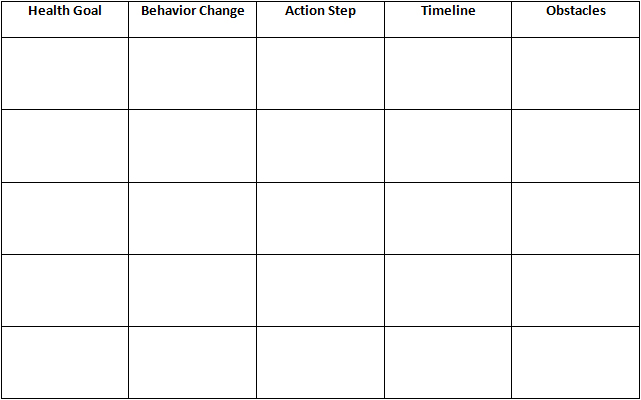Implementing SMART goals when making your New Years Resolution
Recent studies suggest that approximately 45% of Americans usually make a New Year’s Resolution with weight related goals being the number one resolution of choice. Despite this large number only 8% of people are said to be successful in achieving their resolution. Maintaining a healthy body weight is not just about feeling better about your physical appearance- it is vital for good health and prevention of chronic diseases. Let the staff here at Healthy Living Dallas help you make a SMART new year’s resolution or goal and achieve it in a safe and healthy manner.

“The only difference between a dream and a goal is a plan.”The first step is to ask yourself what you are trying to accomplish and why you want to make this specific change.Keep reading for more information on how to create a goal that you can turn to reality and tips and pointers on what to consider when taking the steps to reach your new goal!
This year as you make your goals we’re going to make them SMARTer and then we’ll prioritize them. SMART goals are: Specific, Measurable, Attainable, Realistic, and Timely.
Specific
Do you know exactly what you want to accomplish with your goal?Specific goals are not vague or broad. An example of this would be making the goal “I am going to join ______gym and lift weights three days a week for 45 minutes each day” instead of “I am going to work out more”. Think through what this particular goal will help accomplish and be specific- the more detail the better! How often? How long? What type? With whom? Where?
Measureable
When making a goal don’t forget to state what you are measuring such as time, distance, or days out of the week. For example, are you measuring the amount of steps you take each day, the number of minutes you will run, or the days out of the week you do strength training? Even better- pick several! This way you will be able to measure whether or not the goal has been reached and be able to track progress at any given point of time along the way.
Keeping track of a particular data point has been shown in research to be beneficial to overall successful weight gain. The U.S. Department of Agriculture published an article in March of 2012 called “Diet Self-Monitoring and Body Weight: A Review of Evidence” with results showing that six out of the seven studied reviewed found that when you monitored specific data while pursing weight loss greater weight loss was seen. In many of these diets this self-monitoring included daily record of dietary intake with a primary focus on calories. Focusing on calories isn’t the method that we recommend but tracking food is a wonderful tool.
Katy Widrick wrote a piece in July of 2015 titled “The Fitness Revolution: The Next Generation of Workout Technology” which compares the pros and cons of multiple activity monitors which are available on the market. Here at Healthy Living Dallas, we use the KAM device which provides points based on activity level and based on your individual basal metabolic rate. It’s a great way of “leveling the playing field.” Using your own, unique basal metabolic rate is important because if a marathon runner and someone who has been inactive for 10 years both walk 10,000 steps, the exertion is not the same. For every KAM point you earn, that is 1% of your resting metabolism. The marathon runner will (usually) have a higher metabolism than someone who is inactive and will have to work harder to get 1 point. Learn more about the KAM device by clicking HERE.
Simply tracking what you do and becoming more aware of it can bring about behavioral change, which can increase the chance of achieving your goals in the long-run so make sure that your goals are something you can measure.
Attainable
When making a goal you have to ask yourself if the goal is attainable. Ask yourself if you have the necessary knowledge, skills, abilities, and resources to accomplish that specific goal. In this process, it is important for you to develop a positive attitude and build up a determination mindset that you can do this. Try to set yourself up for success by building an environment around you that can help you meet your goals.You can also ask yourself if meeting the goal will challenge you without defeating you. Remember it is okay to start small and build. For example, if you don’t currently exercise it would not berecommended to make a goal to exercise 90 minutes, 5 days of the week. You would want to start smaller and build your way up so that you don’t tire yourself out after a week. Make sure to prioritize your goal into your current schedule to make it a priority!
Realistic
Ask yourself how willing are you to put forth the effort to make that goal happen? Evaluate your readiness on a scale from 1-10.Healthy Living Dallas has recently added a “readiness questionnaire” to our patient resources tab; check it out by clicking HERE
You should be choosing goals that motivate you and are results focused. We need to be able to list the reason, purpose, or benefit of accomplishing the goal.
Time
When making your goal be sure to establish a reasonable timeline in which you have time complete your goal, but not so much time that you lose focus or motivation. Without a time frame tied to a goal there is no sense of urgency. You should set a start and end date and physically write those dates down and share them with an accountability partner. It is also a good idea to establish benchmarks or short-term goals to monitor improvement towards that final goal and tweak interventions as needed if progress is not being made.
Common New Year’s Resolution Categories
- Lose Weight and Get Fit
- Quit Smoking
- Learn Something New
- Eat Healthier and Diet
- Get Out of Debt and Save Money
- Spend More Time with Family
- Travel to New Places
- Be Less Stressed
- Volunteer
- Drink Less
After the SMART goal is set, it is important to make a list of personal strengths, obstacles, tasks, and rewards.
Identify personal strengths, which include your talents, skills, knowledge, experiences, and interests. Nicole Helprin, director of internal and employee engagement communications for Hewlett-Packard, stated “One of the most important foundations of performance is determining what you’re good at, what you have the potential to be great at, and bringing that (knowledge) to the work that you do.”It is important to identify your strengths so that you can apply them to achieving your goal.
Just as it is important for you to identify your personal strengths, it is important to identify any obstacles you may have when making a goal as well. Some of these obstacles may include: lack of information, lack of skill, discouragement from people surrounding you, time, money, fear of failure, etc. Once you identify your obstacles you can ask yourself, “What can I do about it?” After asking yourself that, you can think of a list of possible solutions and choose the one that is best for you and take action!
It is great to have large goals to aim for, but if the distance between where you are standing right now and your goal is too great, you might be setting yourself up for failure.This is why you may want to consider breaking down your large goal into smaller actionable milestones, as well as include a list of tasks. For example, if your large goal was to run 3 miles in 30 minutes your milestones may be: jog for 5 minutes without stopping, jog for 10 minutes without stopping, jog for 15 minutes without stopping, until you reach 30 minutes. You task list may be: buy running shoes and shorts, shop for healthier food items, and run 5x each week. Hint: If your tasks start with a verb (an action word) they become actionable steps you can take!
To further motivate yourself, you can set a reward you can look forward to when you meet your goal- get creative here and don’t choose rewards that undermine your goal (example: chocolate cake if you’re trying to lose weight!). Using unhealthy food may allow you to start associating unhealthy foods with certain moods, when you feel good about yourself, for instance, it’s okay to reach for a sweet instead of something healthy. Some non-food related rewards may include getting a massage, a new blender for smoothies, splurge on some nice workout clothes, go for a mani/pedi, get yourself a fancy bottle of cologne or perfume, schedule a professional portrait shoot with your family, or even a dream vacation weekend away!
Let 2016 be your year!!!!! Let the staff at Healthy Living Dallas know how we can help you along your health journey and hold you accountable in your goals!

Dallas
3800 San Jacinto
Dallas, TX 75204
(214) 827-8777
Driving DirectionsHours:
Monday, Wednesday,
Friday: 8:00 a.m. - 11:00 a.m.
Tuesday: 4:00 p.m. - 7:00 p.m.Grapevine
823 Ira E. Woods Avenue
Grapevine, TX 76051
(214) 827-8777
Driving DirectionsHours:
Thursday: 1:30 p.m. - 5:00 p.m.






